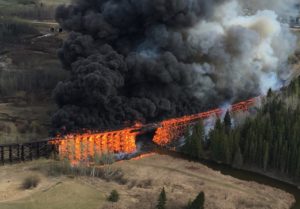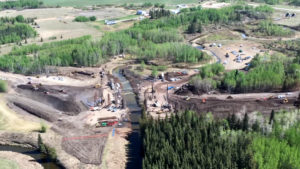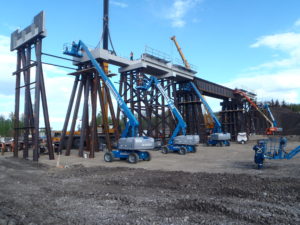Project-in-Focus: Mayerthorpe Rail Bridge Replacement
November 21, 2017 |
Background

On April 26, 2016, the wooden railway trestle bridge over the Little Paddle River near the community of Mayerthorpe, located about 120 km northwest of Edmonton, Alberta, was deliberately set on fire. The bridge was destroyed within a few hours, crippling the railway network owned by Canadian National Railway (CN).
The bridge is an important link in the rail line that carries freight, including oil, lumber, and gravel supplies, to Edmonton from Whitecourt and beyond. CN committed to have a new bridge in service within three weeks. Klohn Crippen Berger (KCB) worked closely with CN Engineering and other contractors to complete the investigation, design and construction monitoring to meet CN’s timeline, and manage the risks associated with the execution of this type of project.

The new bridge was constructed in just 20 days, quickly re-establishing rail service for the communities and resource industries affected by the disruption. On May 15, 2016, the rail line was back in service.
Design Challenges and Solutions
KCB was asked by CN to provide information for the design of the piles, design earthen approach embankments for the new bridge, and monitor their construction. To meet CN’s three-week schedule, crews immediately mobilized to clear the site of debris and contaminated soils resulting from the fire, in preparation for earth moving activities, pile and bridge pier installations, and bridge span fabrication activities.

moving activities, pile and bridge pier
installations, and bridge span fabrication
activities occurred simultaneously on site.
Construction of the approach embankments started almost immediately following site clearing. KCB’s test drill program for the embankment foundation revealed that the foundation soils were weak, consisting of thick alluvial deposits alongside the river. To manage the risk of slope instability during and after construction, the design team adopted an observational approach by monitoring construction-induced pore pressures of the fill using vibrating wire piezometers, and monitoring foundation movements using inclinometers. This round-the-clock construction monitoring gave the design team confidence that their design assumptions and criteria were suitable for the foundation conditions.
Reducing the Environmental Impact
CN wanted to minimize the environmental impact of replacing the Mayerthorpe Bridge. They re-purposed a steel bridge span salvaged from a bridge abandonment project in British Columbia, re-used piles from the former trestle bridge and established an adequate setback distance to minimize the impact of construction activities on the river.

KCB also recommended using locally-sourced earthfill for building the approach embankments, and re-used organic material stripped from the former bridge footprint for building the stabilizing berms at the toe of each embankment. Contaminated materials and soil were disposed of according to applicable environmental regulations, and baseline aquatic and terrestrial habitats were surveyed, protected and monitored during and following construction.
The safety of the construction and design team was paramount – especially given the simultaneous construction activities by multiple parties at a very constricted site. Led by CN, health and safety plans and protocols were established and followed by the entire team, resulting in no reported safety incidents during the project.
Award-winning Project

KCB’s contribution to the project was recognized by the 2017 Showcase Award of Excellence for Transportation Infrastructure by the Consulting Engineers of Alberta (CEA). The project also received the 2017 Canadian Consulting Engineering (CCE) Award of Excellence in the Transportation category. The CCE awards jury was impressed with the team’s agility and ability to make design adjustments considering the very difficult ground conditions, with limited time and data available.
